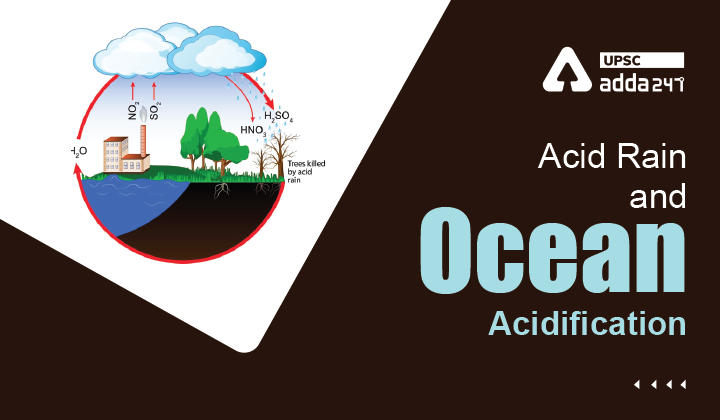Table of Contents
Acid Rain UPSC
Among the many negative impact of air pollution, acid rain is one of the most worrying impacts. IN this article, we will know about the various points important for the UPSC exam.
What is acid rain?
- Any form of precipitation i.e., rain, fog, mist, snow, that is more acidic than normal is called acid rain. Usually, precipitation whose pH of less than 5.6 is termed as acidic.
- Acid rain, also called acid deposition, means any form of precipitation with acidic components, such as sulfuric or nitric acid that fall to the ground from the atmosphere in wet or dry forms.
- Acid rain can include rain, snow, fog, hail or even dust that is acidic.
Cause of acid rain
- When sulfur dioxide (SO2) and nitrogen oxides (NOX) are emitted into the atmosphere and transported by wind and air currents, it results into acid rain.
- The SO2 and NOX react with water, oxygen and other chemicals to form sulfuric and nitric acids.
- These then mix with water and other materials before falling to the ground.
- Natural reason: A small portion of the SO2 and NOX that cause acid rain is from natural sources such as volcanoes.
- Anthropogenic reason: Most of these gases comes from the burning of fossil fuels.
- Major source of these gases
- Burning of fossil fuels to generate electricity. Two thirds of SO2 and one fourth of NOX in the atmosphere come from electric power generators.
- Vehicles and heavy equipment.
- Manufacturing, oil refineries and other industries.
Forms of acid deposition
Wet decomposition
- When the sulfuric and nitric acids formed in the atmosphere fall to the ground mixed with rain, snow, fog, or hail, it is called wet decomposition. It is was commonly is known as acid rain.
Dry decomposition
- Acidic particles and gases can also deposit from the atmosphere in the absence of moisture as dry deposition.
- The acidic particles and gases may deposit to surfaces quickly or may react during atmospheric transport to form larger particles that can be harmful to human health.
Effects of acid rain
- Effects on fish and wildlife: The ecological effects of acid rain are clearly visible in aquatic environments, such as streams and lakes where it can be harmful to fish and other wildlife. The young of most species are more sensitive to environmental conditions than adults. At pH 5, most fish eggs cannot hatch. At lower pH levels, some adult fish die.
- Effects on plants and trees: In the areas affected by acid rain, dead or drying trees are a common sight. Acid rain leaches aluminium from the soil, which may be harmful to plants as well as animals.
- Effects on materials: When acid rain and dry acidic particles fall, the nitric and sulfuric acid can land on statues, buildings, and other manmade structures, and damage their surfaces.
- Effects on visibility: In the atmosphere, SO2 and NOX gases can be transformed into sulfate and nitrate particles, while some NOX can also react with other pollutants to form ozone. All these particles make the air hazy and affects visibility.
- Effects on human health: Many scientific studies have shown that these acidic particles effects heart function, such as heart attacks resulting in death for people with increased heart disease risk, and effects lung function, such as breathing difficulties for people with asthma.
Ocean acidification
What is ocean acidification?
- When carbon dioxide (CO2) dissolves in sea water, it forms carbonic acid, which further decreases the ocean’s pH. This process collectively known as ocean acidification.
- Present ocean acidification occurs approximately ten times faster than anything experienced during the last 300 million years.
Impact of ocean acidification
- Ocean acidification has the potential to change marine ecosystems and impact many ocean-related benefits to society such as coastal protection or provision of food and income.
- Increased ocean temperatures and oxygen loss act concurrently with ocean acidification and constitute the ‘deadly trio’ of climate change pressures on the marine environment.
- Increased sea water acidity has been demonstrated to affect the formation and dissolution of calcium carbonate shells and skeletons in a range of marine species, including corals.
- Changes in species growth and reproduction, as well as structural and functional alterations in ecosystems, will threaten food security, harm fishing industries and decrease natural shoreline protection.
Read current affairs for UPSC





 TSPSC Group 1 Question Paper 2024, Downl...
TSPSC Group 1 Question Paper 2024, Downl...
 TSPSC Group 1 Answer key 2024 Out, Downl...
TSPSC Group 1 Answer key 2024 Out, Downl...
 UPSC Prelims 2024 Question Paper, Downlo...
UPSC Prelims 2024 Question Paper, Downlo...
